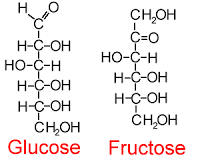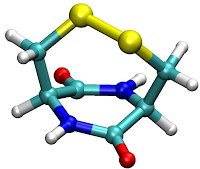Biology
The Four Organic Compounds
 1. Carbohydrates are the compound that provide energy to living cells. They are the main energy source because they activate instant cellular energy. The carbohydrates we use as food comes from photosynthesis of plants. The compounds monomers are monosaccharides or a single simple sugar (glucose, fructose) and disaccharides or two simple sugars bonded together.
1. Carbohydrates are the compound that provide energy to living cells. They are the main energy source because they activate instant cellular energy. The carbohydrates we use as food comes from photosynthesis of plants. The compounds monomers are monosaccharides or a single simple sugar (glucose, fructose) and disaccharides or two simple sugars bonded together.
2. Lipids function as energy storage, structural components of cell membranes, and as signaling molecules. This compound is made up of naturally occurring molecules such as fat, waxes, sterols, etc. Fats are the biggest group of lipids. The monomers of this compound are fatty acids and glycerol.
3. Proteins are involved in nearly all cell functions, each having their own specific function within the body. Proteins are used for structural support, bodily movement, and defense against germs. Antibodies, enzymes, hormonal proteins, and storage proteins are all types of protein with different functions. They not only vary in function but structure as well, each one is a distinct three dimensional shape. The monomers of this compound are are amino acids.

4. Nucleic Acids transfer genetic information from one generation to the next in living organisms. There are 2 types of nucleic acid; deoxyribonucleic acid (DNA), and ribonucleic acid (RNA). Each have their own role in transferring genetic information. The monomers of it are nucleotides, which have three parts; a nitrogenous base, a five carbon sugar, and a phosphate group.
- #103 The Light-independent Reactions (calvin Cycle)
The light-independent reactions take place in the stroma of the chloroplast, where the enzyme ribulose bisphosphate carboxylase, usually known as rubisco, is found. 1. Carbon fixation CO2 diffuses into the stroma from the air spaces within the...
- #86 Energy And Atp
All living organisms need a continuous supply of energy to maintain their metabolism. They must absorb either light energy in photosynthesis or chemical potential energy to do the work necessary to stay alive. Such work includes: ? Anabolic reactions:...
- #16 Summary Of Biological Molecules
From small to large 1. The larger biological molecules are made from smaller molecules. Polysaccharides are made from monosaccharides, proteins from amino acids, nucleic acids from nucleotides, lipids from fatty acids and glycerol. 2. Polysaccharides,...
- Metabolism
METABOLISM All the biochemical reactions taking place inside a living system together constitute metabolism. E.g.GlycolysisKreb's cycleRespirationPhotosynthesis Removal of CO2 from amino acids to form amine.Removal of amino group in a nucleotide...
- Structure Of Living Beings.
Differentiation between living beings and inert matter is an easy question, at least in appearance. This is, however, because we usually think about living things that can be clearly seen growing, moving or, summing up, changing. But if we take...
Biology
Organic Compounds
The Four Organic Compounds
 1. Carbohydrates are the compound that provide energy to living cells. They are the main energy source because they activate instant cellular energy. The carbohydrates we use as food comes from photosynthesis of plants. The compounds monomers are monosaccharides or a single simple sugar (glucose, fructose) and disaccharides or two simple sugars bonded together.
1. Carbohydrates are the compound that provide energy to living cells. They are the main energy source because they activate instant cellular energy. The carbohydrates we use as food comes from photosynthesis of plants. The compounds monomers are monosaccharides or a single simple sugar (glucose, fructose) and disaccharides or two simple sugars bonded together. 2. Lipids function as energy storage, structural components of cell membranes, and as signaling molecules. This compound is made up of naturally occurring molecules such as fat, waxes, sterols, etc. Fats are the biggest group of lipids. The monomers of this compound are fatty acids and glycerol.
3. Proteins are involved in nearly all cell functions, each having their own specific function within the body. Proteins are used for structural support, bodily movement, and defense against germs. Antibodies, enzymes, hormonal proteins, and storage proteins are all types of protein with different functions. They not only vary in function but structure as well, each one is a distinct three dimensional shape. The monomers of this compound are are amino acids.

4. Nucleic Acids transfer genetic information from one generation to the next in living organisms. There are 2 types of nucleic acid; deoxyribonucleic acid (DNA), and ribonucleic acid (RNA). Each have their own role in transferring genetic information. The monomers of it are nucleotides, which have three parts; a nitrogenous base, a five carbon sugar, and a phosphate group.
- #103 The Light-independent Reactions (calvin Cycle)
The light-independent reactions take place in the stroma of the chloroplast, where the enzyme ribulose bisphosphate carboxylase, usually known as rubisco, is found. 1. Carbon fixation CO2 diffuses into the stroma from the air spaces within the...
- #86 Energy And Atp
All living organisms need a continuous supply of energy to maintain their metabolism. They must absorb either light energy in photosynthesis or chemical potential energy to do the work necessary to stay alive. Such work includes: ? Anabolic reactions:...
- #16 Summary Of Biological Molecules
From small to large 1. The larger biological molecules are made from smaller molecules. Polysaccharides are made from monosaccharides, proteins from amino acids, nucleic acids from nucleotides, lipids from fatty acids and glycerol. 2. Polysaccharides,...
- Metabolism
METABOLISM All the biochemical reactions taking place inside a living system together constitute metabolism. E.g.GlycolysisKreb's cycleRespirationPhotosynthesis Removal of CO2 from amino acids to form amine.Removal of amino group in a nucleotide...
- Structure Of Living Beings.
Differentiation between living beings and inert matter is an easy question, at least in appearance. This is, however, because we usually think about living things that can be clearly seen growing, moving or, summing up, changing. But if we take...
